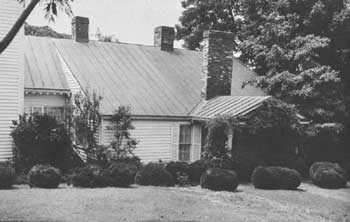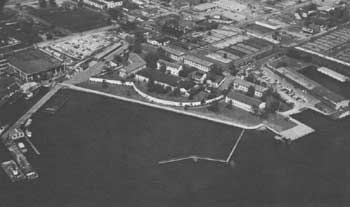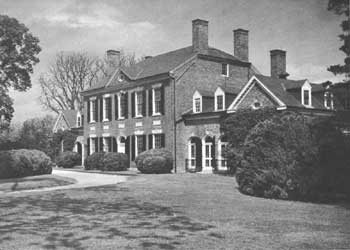





Survey of Historic Sites and Buildings
 |
AQUIA CREEK QUARRIES Virginia |
|
| ||
Sandstone from these quarries was used in constructing the Capitol and the White House. Early in the winter of 1791-92 Maj. Pierre Charles L'Enfant, designer of the Capital City, went to Aquia, Va., and on behalf of the Government purchased Wigginton's Island and leased for a 10-year period land along Aquia Creek. On this land, workers quarried the sandstone used for the outer walls of the Capitol and the White House and in other Government buildings. Today, Wigginton's Island is difficult to reach by land, via a causeway. The approach road is impassable in some places. The vegetation is thick, and only a few quarry sites show evidence of stonecutting.
 |
| This small rear section of the present mansion at Ash Lawn, Virginia, was the home of President James Monroe for more than 20 years. The two story front part, partly visible in this photograph, is a later addition. |
 |
ASH LAWN Virginia |
|
| ||
Ash Lawn, situated on a hilltop about 2 miles from Jefferson's Monticello, was the home of James Monroe from November 1799 until near the end of his first term as President, in 1820. Because of his busy career, he stayed at the home only intermittently. Jefferson supervised construction, which began in 1796 during Monroe's absence as Minister to France. Built on a rather steep slope, the house was a modest, seven-room structure, having one story in front and two behind. Several outbuildings stood on the 3,500-acre estate. The landscaping, which Monroe supervised, included a boxwood garden. The present house stands at the head of a long wooded lawn. Its main section is a two-story addition to Monroe's original house, which is connected to the back of the main section. The house is privately owned, but is open to the public.
 |
| Aerial view of Fort Norfolk, Virginia. This fort, one of the Nation's earliest coastal defenses, was erected because of French and English attacks on U.S. shipping in the 1790's. Courtesy, U.S. Army. |
 |
FORT NORFOLK Virginia |
|
| ||
In 1794 Congress authorized the building of Fort Norfolk as a defense for Norfolk and the upper reaches of the Elizabeth River. The fort was one of a series of coastal defenses erected because of French and English attacks on U.S. shipping. In 1795 construction began. In 1802 Secretary of War Henry Dearborn visited Norfolk and ordered the fort dismantled and a new one constructed at Ferry Point. In 1807 the Chesapeake embarked from Norfolk, but was intercepted about 10 miles off Cape Henry by the British frigate Leopard, which opened fire. The Chesapeake's commander struck his flag, and the Leopard officers boarded the ship and removed three U.S. sailors and a British deserter. This incident outraged Norfolk citizens, who persuaded the Federal Government to reactivate Fort Norfolk. During the War of 1812 troops from the fort reconstructed a redoubt on Craney Island, where they repelled a British attack on Norfolk. Several Civil War actions also occurred at the fort.
The irregular-shaped fort is about 400 feet long and 250 feet wide. On the west side, facing the main river approach, the parapet is in the shape of a half moon; on the northwest, it forms an acute angle; on the northeast, a full bastion; and, on the southeast, a bastion of irregular design. The face of the fort is brick, but the terreplein and the banquettes are of sodded dirt. Traces of a ditch may be seen on the land side in front of the northeast bastion. Inside the fort are numerous buildings, probably once used as magazines, storehouses, barracks, and officers' quarters. All are in a good state of repair. The fort, which is owned and maintained by the U.S. Army, in cooperation with the Norfolk Historical Society, is open to the public.
 |
JAMES MONROE LAW OFFICE Virginia |
|
| ||
This quaint 1-1/2-story building represents a typical late 18th-century law office. Inside are housed a collection of furniture, portraits, and personal possessions of James Monroe. Built in 1758, the building was the first and only private law office of Monroe. After serving in the War for Independence, Monroe studied law in Richmond, and by 1786, when he moved to Fredericksburg, had become a member of the Virginia Assembly, the State Executive Council, and the Continental Congress. He practiced law in this office from 1786 until 1789, when he was elected U.S. Senator. He later served as Minister to France, Spain, and England; Governor of Virginia for two terms; Secretary of War; Secretary of State; and President for two terms.
Many of Monroe's possessions have been removed from his Oak Hill estate to the law office, where they are displayed. Among the exhibits is the Louis XVI desk, having secret compartments, on which Monroe signed the message to Congress that contained the Monroe Doctrine. Behind the law office is an old-fashioned garden containing a century-old mulberry tree at the center. At the end of the boxwood-lined walks stands a bronze bust of Monroe. In 1927 Monroe's descendants opened the building to the public and in 1947 presented it to the James Monroe Memorial Foundation. In 1961 a two-story memorial library wing was added to the rear of the office. In 1964 the foundation donated the structure to the University of Virginia. It is open to the public.
NHL Designation: 11/13/66
 |
SHADWELL Virginia |
|
| ||
Shadwell was the plantation home in which Thomas Jefferson was born, in 1743. About 1737 Jefferson's father, Peter, had built it on land he had purchased 1 year or so earlier from William Randolph. Jefferson lived in it for the first 2 years of his life, and again during the years 1752-70, on an intermittent basis. Fire destroyed the home in 1770, and the site was subsequently lost. In 1955, however, archeologists, after a 14-year search, located it. The style of the original house is unknown, but architects, under the auspices of the Jefferson Birthplace Memorial Park Commission, designed and built a 1-1/2-story clapboard home faithful to the era and mode of life of Jefferson's parents.
 |
| Mansion at Woodlawn Plantation, Virginia. Designed by architect William Thornton, it was the home of George Washington's adopted daughter, Nelly, after her marriage to Lawrence Lewis. |
 |
WOODLAWN PLANTATION Virginia |
|
| ||
This estate was selected and surveyed by George Washington and presented as a wedding gift to his adopted daughter, Eleanor Parke (Nelly) Custis, who married his nephew Lawrence Lewis. It consisted of 2,000 acres of Washington's Mount Vernon lands. As a house site Washington recommended the hill overlooking Dogue Creek, the Potomac River, and the mansion at Mount Vernon. Dr. William Thornton, first architect of the U.S. Capitol, designed a mansion for the young couple, who lived at Mount Vernon until 1802, when they moved into the uncompleted mansion. In 1805 it was completed. The Lewises lived there until Lawrence's death, in 1839, when Nelly abandoned the estate, which then fell into ruin. Beginning in 1846 it passed through many ownerships. In 1948 the Woodlawn Public Foundation purchased the mansion and grounds and 9 years later turned them over to the National Trust for Historic Preservation, which directed restoration of the mansion, furnished it, and opened it to the public.
The mansion is of five-part construction—a central portion with two flanking wings and connecting hyphens. Beyond it are a smokehouse and a dairy, both linked to the wings by brick walls, penetrated by solid wooden doors. The mansion is built of brick, burned on the grounds, and trimmed with local Aquia sandstone. The river facade is noteworthy for its handsome portico and columns, marble floor, and double stairway leading to the garden. Within the mansion are imported mantelpieces of carved marble and molded compo ornaments in classic design. The wood work is handsomely detailed. The winding stair and carved mahogany rail in the central hall are noteworthy. Restoration includes original paint colors for the walls. Mementos of Nelly Lewis' years at Mount Vernon are displayed, as well as memorabilia of the Washington and Lewis families.
NHL Designation: 08/05/98
 |
 |
http://www.cr.nps.gov/history/online_books/founders-frontiersmen/sitee19.htm
Last Updated: 29-Aug-2005